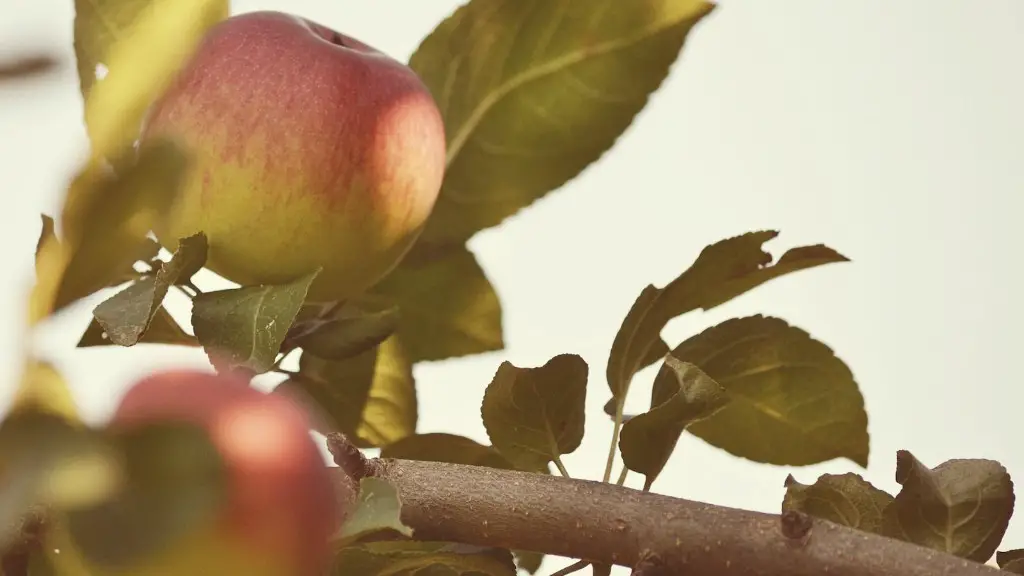A healthy apple tree requires proper care and maintenance to survive. An apple tree needs a location with enough sunlight and good drainage, a fertile soil rich in organic material, regular irrigation, and proper pruning and pest prevention to guarantee success. Contrarily, inadequate soil, excessive heat or cold, or a lack of moisture may jeopardize the tree’s health and ultimately its life. Here we discuss in detail some of the factors that an apple tree needs to survive.
Location and Sunlight
An apple tree needs the right location with adequate sunlight, preferably at least 6 hours of full sun daily. Choosing a spot with full sunlight allows the tree to fully blossom and grow its fruits. Additionally, the location should be fenced-in or otherwise sheltered from strong winds and cold temperatures, as extreme weather can cause damage to the tree and prevent it from properly flourishing.
Soil and Irrigation
Good quality and well-drained soil are essential for the tree’s survival. To prevent nutrients from leaching out of the soil too quickly due to regular irrigation, mix compost or manure into the soil. Depending on the local weather conditions, a grafted apple tree may require about 25-50 liters of water for every square foot each month. Adequate irrigation helps the tree grow healthy roots and take advantage of the nutrients in the soil.
Pruning and Pest Prevention
Regular pruning is essential to maintain the tree’s shape and size, as well as remove dead or diseased branches that reduce its productivity. Furthermore, a healthy apple tree requires frequent pest control to prevent the invasion of unwanted insects which can damage the leaves and fruits. Organic pest treatments and cover sprays are usually more effective than chemical options.
Design and Nutrients
Planting apple trees in a location with an adequate design can prevent unnecessary water loss and encourage the development of healthy fruit. Furthermore, the tree needs to be regularly fertilized with an appropriate blend of macro and micronutrients, such as nitrogen, phosphorus, potassium, calcium, iron, and manganese to keep it in optimal condition and promote fruit production.
Mulching and Weed Control
Mulching is also important for apple tree maintenance. Use a 2-3 inch layer of organic matter, such as manure or compost, to conserve water and protect the tree’s roots from temperature extremes. Additionally, weeds can compete for the plant’s nutrients and water, and so regular weeding is important to prevent such competition.
Staking and Training
Staking is also necessary for larger apple trees that may be subject to strong winds and need further support. As for training, proper pruning is necessary in the early stages of growth to its shape and promote the development of vigorous shoots. Early training can help avoid the need for more extensive pruning in the future.
Systemic Insecticides
Systemic insecticides are useful to protect apple trees against potential damage caused by pests. Such insecticides are administered through the soil and spread throughout the tree, thus providing protection against persistent invasive insects such as borers, mites, aphids, and codling moths.
Soil Fumigants
Soil fumigants are a chemical approach to pest control and are useful to eliminate or reduce the populations of persistent pest species in the tree’s root zone. These treatments are usually used in combination with other pest prevention strategies and help reduce the risk of the tree’s decline due to pest infestations.
Disease Prevention
Apple trees are also susceptible to disease, and proper protection from fungal, viral, and bacterial diseases is necessary to maintain the tree’s health. Depending on the local disease pressure, fungicides and other disease prevention treatments may be necessary to ensure the tree avoidance of damage. Additionally, proper sanitation measures, such as removing excess debris from the tree canopy and destroying affected branches, can help limit the spread of disease.
Control of Competing Vegetation
Lastly, apple trees need to be regularly checked for plants competing for the same resources, such as weeds and vines. Such competing vegetation can absorb the tree’s resources, reduce light availability and cause overall damage, so they must be removed promptly.


